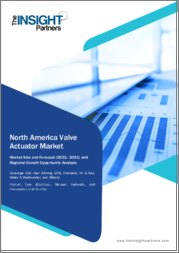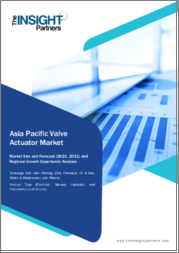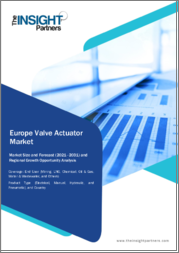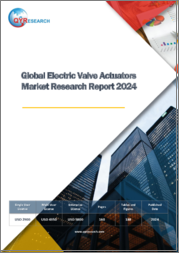
|
시장보고서
상품코드
1447005
해군용 액추에이터 및 밸브 시장 예측(-2030년) : 제품 유형별, 유형별, 플랫폼별, 재료별, 용도별, 지역별 세계 분석Naval Actuators and Valves Market Forecasts to 2030 - Global Analysis By Product Type, Type, Platform, Material, Application and by Geography |
||||||
Stratistics MRC에 따르면, 세계 해군용 액추에이터 및 밸브 시장은 2023년 29억 달러 규모이며, 예측 기간 동안 연평균 7.84% 성장하여 2030년에는 49억 2,000만 달러에 달할 것으로 예상됩니다.
해군용 액추에이터와 밸브는 다양한 시스템에서 가스와 유체의 정확한 제어를 보장하기 때문에 해군 함정의 효과적인 운용에 필수적입니다. 액추에이터는 에너지를 운동으로 변환하는 기계 장치로, 가스 및 액체의 흐름을 제어하는 선박의 밸브의 움직임을 가능하게 합니다. 이 부품은 안전 시스템, 항해 및 추진과 같은 중요한 작업에 필수적입니다. 이러한 부품의 신뢰성과 반응성은 선박의 원활한 운영에 필수적이며, 선박의 일반적인 성능과 임무 성공률을 모두 향상시킵니다.
국제해사기구(IMO)에 따르면 표준화된 안전 조치와 프로토콜을 효과적으로 시행하는 것이 전 세계 해양 활동의 안전과 지속가능성을 보장하는 데 가장 중요하다고 합니다.
해군 현대화를 위한 노력
해군의 현대화 노력은 해군용 액추에이터 및 밸브 시장을 주도하는 세계적인 추세입니다. 전 세계적으로 정부 및 방위 기관은 해군 함대의 현대화 및 확장을 위해 예산을 배정하고 있습니다. 기술적으로 진보된 선박 및 시스템 획득에 중점을 두는 것과 마찬가지로 첨단 해군용 액추에이터 및 밸브의 통합은 현대 해상 방어에 대한 증가하는 수요를 충족시키는 데 필수적입니다. 또한, 각국이 변화하는 지정학적 위협에 대응하기 위해 해군력을 강화함에 따라 이러한 추세는 앞으로도 계속될 것으로 예상됩니다.
통합의 과제와 기술적 과제
최첨단 기술을 통합하고 해군 시스템의 복잡성을 관리하는 것은 통합 문제 및 기술 문제로 이어질 수 있습니다. 새로운 액추에이터 및 밸브는 기존 해군 플랫폼, 시스템 및 통신 프로토콜과의 상호 운용성 측면에서 큰 도전에 직면할 수 있습니다. 전체 시스템의 성능과 신뢰성을 희생하지 않고 원활한 통합을 보장하기 위해 철저한 테스트와 검증이 필요한 경우, 배치가 지연될 수 있습니다. 또한, 오래된 시스템에서 보다 정교한 솔루션으로 전환할 때 발생할 수 있는 기술적 문제는 현대화 노력에 복잡성을 더할 수 있습니다.
무인시스템에 대한 요구 증가
해군용 액추에이터 및 밸브 시장은 수중 드론과 무인 수상함정(USV)과 같은 무인 시스템의 사용이 증가함에 따라 큰 폭의 성장이 예상됩니다. 전 세계 해군이 자율 및 원격 제어 기술을 연구함에 따라 무인 플랫폼용으로 제작된 특수 액추에이터와 밸브의 필요성이 점점 더 커지고 있습니다. 또한, 앞서 언급한 부품은 다양한 해양 환경에서 장시간 작동을 견딜 수 있기 때문에 제조업체는 변화하는 무인 해군 시스템의 요구에 맞는 맞춤형 및 독창적인 솔루션을 만들어 제공할 수 있을 것으로 예상됩니다.
의존관계와 공급망 혼란
공급망 중단과 의존성은 특히 중요한 부품이 제한된 지역에서 조달되는 경우, 해군용 액추에이터 및 밸브 시장에 위협이 될 수 있습니다. 전염병, 자연 재해, 지정학적 불안은 모두 중요한 부품의 공급과 제조를 방해하여 지연과 부족을 유발할 수 있습니다. 또한 전략적 비축과 공급망 다각화는 이러한 위험을 줄이는 데 도움이 되지만, 예기치 않은 중단에 대처하고 해군 시스템 부품의 안정적인 공급을 보장하기 위해서는 지속적인 모니터링과 대비가 필요합니다.
COVID-19의 영향:
노동력 부족, 공급망 혼란, 국방 프로젝트 연기 등의 문제로 인해 COVID-19 사태는 해군용 액추에이터 및 밸브 시장에 큰 영향을 미치고 있습니다. 전염병으로 인한 세계 경제 둔화로 인해 현재 국방 지출이 제한되어 현대화 및 조달 계획에 영향을 미치고 있습니다. 제조 및 공급망 중단으로 인해 생산 지연과 필수 부품의 납품이 지연되고 있습니다. 또한, 여행 제한 및 사회적 거리두기 조치로 인해 인력 가동률이 영향을 받고 있으며, 이는 현장 활동을 어렵게 하고 프로젝트 지연에 영향을 미치고 있습니다.
예측 기간 동안 항공모함 부문이 가장 큰 비중을 차지할 것으로 예상
해군용 액추에이터 및 밸브는 항공모함 부문이 가장 큰 시장 점유율을 차지할 것으로 예상됩니다. 해군 전력 투사의 중심인 항공모함은 항공 작전, 항해 및 추진과 같은 중요한 시스템을 위해 정교하고 신뢰할 수 있는 액추에이터와 밸브를 필요로 합니다. 함정의 크기와 복잡성으로 인해 다양한 시스템의 가스 및 유체 흐름을 정확하게 제어하기 위해 다양한 액추에이터와 밸브가 필요합니다. 또한, 해군의 전략적 역량에 대한 필요성으로 인해 전 세계 항공모함 함대의 현대화와 성장이 계속되고 있으며, 이 시장에서 고성능 해군용 액추에이터 및 밸브에 대한 수요가 크게 증가하고 있습니다.
추진 시스템 분야는 예측 기간 동안 가장 높은 CAGR을 기록할 것으로 예상
추진 시스템 분야는 가장 높은 CAGR을 보일 것으로 예상됩니다. 선박의 추진 시스템은 선박의 효과적인 이동에 필수적이며, 정밀한 제어 메커니즘은 정교한 액추에이터와 밸브를 통해 실현됩니다. 이 시장은 전 세계 해군 현대화 추진으로 인해 보다 진보되고 에너지 효율적인 추진 시스템에 대한 필요성이 증가함에 따라 크게 성장할 것으로 예상됩니다. 또한, 현대식 액추에이터와 밸브는 해군이 작전 능력과 환경적 지속가능성을 향상시키기 위해 추진 시스템 분야에서 요구되고 있습니다.
가장 큰 점유율을 차지하는 지역
북미 지역이 해군용 액추에이터 및 밸브 시장에서 가장 큰 시장 점유율을 차지할 것으로 예상됩니다. 미국은 강력한 해군력을 보유하고 있으며 해군 함대 현대화에 지속적으로 투자하고 있으며, 이는 북미 지역의 우위에 기여하고 있습니다. 이 지역의 정교한 액추에이터 및 밸브에 대한 수요는 미 해군의 기술 혁신에 대한 관심과 일류 방산업체와의 전략적 파트너십 및 제휴에 크게 영향을 받고 있습니다. 또한, 북미는 중요한 업계 기업의 존재, 진행 중인 해군 현대화 프로그램, 해상 우위 유지에 대한 강력한 노력으로 인해 해군용 액추에이터 및 밸브의 주요 시장으로 자리매김하고 있습니다.
CAGR이 가장 높은 지역:
아시아태평양의 해군용 액추에이터 및 밸브 시장은 가장 높은 CAGR로 성장할 것으로 예상됩니다. 중국, 인도, 일본과 같은 국가들은 아시아태평양의 급속한 경제 성장, 지정학적 불안정, 해양 안보에 대한 우려의 증가로 인해 해군 현대화에 대규모 투자를 하고 있습니다. 이들 국가들이 해군 함정의 효율성과 능력을 향상시키기 위해 적극적으로 함대를 현대화하고 확장함에 따라 최신 액추에이터와 밸브에 대한 수요가 증가하고 있습니다. 또한, 아시아태평양의 급격한 성장은 전략적 동맹 관계, 국내 방위 제조 및 해상 전력 투사에 대한 중요성 증가 등 여러 가지 요인에 기인합니다.
무료 커스터마이징 서비스
이 보고서를 구독하는 고객은 다음과 같은 무료 맞춤화 옵션 중 하나를 사용할 수 있습니다:
- 기업 개요
- 추가 시장 기업의 종합적인 프로파일링(최대 3개사까지)
- 주요 기업 SWOT 분석(최대 3개사)
- 지역 세분화
- 고객의 관심에 따른 주요 국가별 시장 추정치, 예측, CAGR(주: 타당성 검토에 따른)
- 경쟁사 벤치마킹
- 제품 포트폴리오, 지리적 입지, 전략적 제휴를 기반으로 한 주요 기업 벤치마킹
목차
제1장 주요 요약
제2장 서문
- 개요
- 이해관계자
- 조사 범위
- 조사 방법
- 데이터 마이닝
- 데이터 분석
- 데이터 검증
- 조사 접근법
- 조사 소스
- 1차 조사 소스
- 2차 조사 소스
- 가정
제3장 시장 동향 분석
- 성장 촉진요인
- 성장 억제요인
- 기회
- 위협
- 제품 분석
- 용도 분석
- 신흥 시장
- 신종 코로나바이러스 감염증(COVID-19)의 영향
제4장 Porter's Five Forces 분석
- 공급 기업의 교섭력
- 구매자의 교섭력
- 대체품의 위협
- 신규 참여업체의 위협
- 경쟁 기업 간의 경쟁 관계
제5장 세계의 해군용 액추에이터 및 밸브 시장 : 제품 유형별
- 액추에이터
- 유압 액추에이터
- 공기압 액추에이터
- 전동 액추에이터
- 기계식 액추에이터
- 하이브리드 액추에이터
- 밸브
- 볼 밸브
- 게이트 밸브
- 버터플라이 밸브
- 글러브 밸브
- 체크 밸브
- 기타 제품 유형
제6장 세계의 해군용 액추에이터 및 밸브 시장 : 유형별
- 선형 액추에이터
- 로터리 액추에이터
- 기타 유형
제7장 세계의 해군용 액추에이터 및 밸브 시장 : 플랫폼별
- 항공모함
- 잠수함
- 구축함
- 프리깃함
- 코르벳함
- 수륙양용함
- 해상 패트롤카
- 기타 플랫폼
제8장 세계의 해군용 액추에이터 및 밸브 시장 : 재료별
- 알루미늄
- 스테인리스강
- 합금 기반
- 기타 소재
제9장 세계의 해군용 액추에이터 및 밸브 시장 : 용도별
- 추진 시스템
- 연료 시스템
- HVAC 시스템
- 소화 시스템
- 밸러스트 시스템
- 기타 용도
제10장 세계의 해군용 액추에이터 및 밸브 시장 : 지역별
- 북미
- 미국
- 캐나다
- 멕시코
- 유럽
- 독일
- 영국
- 이탈리아
- 프랑스
- 스페인
- 기타 유럽
- 아시아태평양
- 일본
- 중국
- 인도
- 호주
- 뉴질랜드
- 한국
- 기타 아시아태평양
- 남미
- 아르헨티나
- 브라질
- 칠레
- 기타 남미
- 중동 및 아프리카
- 사우디아라비아
- 아랍에미리트
- 카타르
- 남아프리카공화국
- 기타 중동 및 아프리카
제11장 주요 발전
- 계약, 파트너십, 협업, 합작투자
- 인수와 합병
- 신제품 발매
- 사업 확대
- 기타 주요 전략
제12장 기업 개요
- Emerson Electric Co.
- Schlumberger Ltd
- Honeywell International Inc.
- AUMA Riester GmbH & Co. KG
- Wartsila Corporation
- Parker Hannifin Corporation
- Eaton Corporation plc
- Bosch Rexroth AG(Robert Bosch GmbH)
- Flowserve Corporation
- Rockwell Automation, Inc
- Curtiss-Wright Corporation
- Rotork plc
- Moog Inc.
According to Stratistics MRC, the Global Naval Actuators and Valves Market is accounted for $2.90 billion in 2023 and is expected to reach $4.92 billion by 2030 growing at a CAGR of 7.84% during the forecast period. Naval actuators and valves are essential to the effective operation of naval ships because they guarantee accurate control of gases and fluids in a variety of systems. Actuators, which are mechanical devices that transform energy into motion, enable the movement of valves on ships to control the flow of gases or liquids. These parts are essential to vital operations like safety systems, navigation, and propulsion. These parts dependability and responsiveness are crucial to the seamless operation of naval ships, which enhances both their general performance and mission success.
According to the International Maritime Organization (IMO), the effective implementation of standardized safety measures and protocols is paramount to ensuring the security and sustainability of global maritime activities.
Market Dynamics:
Driver:
Initiatives for naval modernization
Naval modernization initiatives are a major global trend driving the market for naval actuators and valves. All across the world, budgets for the modernization and enlargement of naval fleets are being allocated by governments and defense agencies. The integration of sophisticated naval actuators and valves is imperative to meet the increased demands of modern maritime defense, as is the focus on acquiring technologically advanced vessels and systems. Additionally, it is anticipated that this trend will continue as countries look to strengthen their naval forces in response to shifting geopolitical threats.
Restraint:
Issues with integration and technical challenges
Embedding cutting-edge technologies and managing the complexity of naval systems can lead to integration problems and technical challenges. New actuators and valves may face major challenges when it comes to interoperability with current naval platforms, systems, and communication protocols. Deployment may be delayed if thorough testing and validation are needed to ensure smooth integration without sacrificing overall system performance and reliability. Furthermore, complexity is added to modernization efforts by the possibility of technical difficulties during the switch from outdated systems to more sophisticated solutions.
Opportunity:
Growing requirement for unmanned systems
The market for naval actuators and valves is expected to witness substantial growth due to the growing utilization of unmanned systems, such as underwater drones and unmanned surface vessels (USVs). Specialized actuators and valves made for unmanned platforms are becoming more and more necessary as navies throughout the world investigate autonomous and remotely operated technologies. Moreover, the aforementioned components are capable of withstanding prolonged operation in a variety of marine environments, presenting prospects for manufacturers to create and provide inventive solutions customized to the changing needs of unmanned naval systems.
Threat:
Dependencies and supply chain disruptions
Supply chain interruptions and dependencies pose a threat to the naval actuators and valves market, particularly when essential components are sourced from restricted areas. Pandemics, natural disasters, and geopolitical unrest can all impede the supply and manufacture of vital parts, causing delays and shortages. Furthermore, strategic stockpiling and supply chain diversification can help to lessen these risks, but continual monitoring and preparation are necessary to deal with unanticipated interruptions and guarantee a steady supply of naval system components.
Covid-19 Impact:
Due to issues including labor shortages, supply chain disruptions, and postponements in defense projects, the COVID-19 pandemic has had a major effect on the market for naval actuators and valves. Defense spending is now limited due to the pandemic-caused global economic slowdown, which has an impact on modernization and procurement plans. Production delays and the delivery of essential components have resulted from disruptions in the manufacturing and supply chains. Additionally, the workforce's availability has been impacted by travel restrictions and social distancing measures, which have also made on-site activities more difficult and contributed to project delays.
The Aircraft Carriers segment is expected to be the largest during the forecast period
It is projected that the aircraft carrier segment will hold the largest market share for naval actuators and valves. As the focal point of naval power projection, aircraft carriers require sophisticated and dependable actuators and valves for vital systems like aviation operations, navigation, and propulsion. Because of their size and complexity, these vessels need a wide variety of actuators and valves to provide accurate control over the flows of gases and fluids in different systems. Moreover, the need for strategic naval capabilities has led to the ongoing modernization and growth of aircraft carrier fleets around the world, which has greatly increased demand for high-performance naval actuators and valves in this market.
The Propulsion Systems segment is expected to have the highest CAGR during the forecast period
The Propulsion Systems segment is projected to have the highest CAGR. Naval vessel propulsion systems are essential to their effective movement, and their precise control mechanisms are made possible by sophisticated actuators and valves. This market is expected to grow significantly due to the worldwide push for naval modernization, which is driving the need for more advanced and energy-efficient propulsion systems. Furthermore, modern actuators and valves are needed in the propulsion systems segment as navies look to improve their operational capabilities and environmental sustainability.
Region with largest share:
North America is predicted to hold the largest market share for naval actuators and valves. The United States has strong naval capabilities and continuously invests in modernizing its naval fleet, which contributes to North America's dominance. The region's need for sophisticated actuators and valves is greatly influenced by the U.S. Navy's emphasis on technological innovation as well as its strategic partnerships and alliances with top defense contractors. Additionally, North America is a leading market for naval actuators and valves due in part to the presence of important industry players, ongoing naval modernization programs, and a strong commitment to maintaining maritime superiority.
Region with highest CAGR:
The naval actuators and valves market is anticipated to grow at the highest CAGR in the Asia-Pacific region. Countries like China, India, and Japan have made large investments in naval modernization as a result of the Asia-Pacific region's rapid economic growth, escalating geopolitical unrest, and growing concerns about maritime security. Modern actuators and valves are in high demand as a result of these countries' aggressive fleet modernization and expansion, which aims to improve the effectiveness and capabilities of their naval ships. Moreover, the Asia-Pacific region's rapid growth can be attributed to several factors, including the growing emphasis on strategic alliances, indigenous defense manufacturing, and maritime power projection.
Key players in the market
Some of the key players in Naval Actuators and Valves market include Emerson Electric Co., Schlumberger Ltd, Honeywell International Inc., AUMA Riester GmbH & Co. KG, Wartsila Corporation, Parker Hannifin Corporation, Eaton Corporation plc, Bosch Rexroth AG (Robert Bosch GmbH), Flowserve Corporation, Rockwell Automation, Inc, Curtiss-Wright Corporation, Rotork plc and Moog Inc.
Key Developments:
In October 2023, Rockwell Automation, Inc., the world's largest company dedicated to industrial automation and digital transformation, today announced it has signed a definitive agreement to acquire Verve Industrial Protection, a cybersecurity software and services company that focuses specifically on industrial environments, expanding the offerings of Rockwell with an industry-leading asset inventory system and vulnerability management solution.
In August 2023, Emerson announced a definitive agreement to acquire FLEXIM Flexible IndustriemeBtechnik GmbH, a global leader in clamp-on ultrasonic flow measurement for liquids, gases and steam. Headquartered in Berlin, Germany, Flexim brings highly differentiated, complementary technology and strong customer relationships to Emerson, with an installed base of more than 100,000 flowmeters, as well as approximately 450 employees.
In June 2023, Honeywell International Inc. HON has entered into a definitive agreement to acquire heads-up-display (HUD) assets of Swedish aerospace and defense company Saab Technology. The financial terms of the transaction are kept under wraps. The HUD system reduces the workload for pilots, helps them with increased situational awareness and increases flight safety. Per the deal, the companies will collaborate to advance and strengthen HON's HUD product portfolio.
Product Types Covered:
- Actuators
- Valves
- Other Product Types
Types Covered:
- Linear Actuators
- Rotary Actuators
- Other Types
Platforms Covered:
- Aircraft Carriers
- Submarines
- Destroyers
- Frigates
- Corvettes
- Amphibious Ships
- Offshore Patrol Vehicles
- Other Platforms
Materials Covered:
- Aluminum
- Stainless Steel
- Alloy-based
- Other Materials
Applications Covered:
- Propulsion Systems
- Fuel Systems
- HVAC Systems
- Fire Suppression Systems
- Ballast Systems
- Other Applications
Regions Covered:
- North America
- US
- Canada
- Mexico
- Europe
- Germany
- UK
- Italy
- France
- Spain
- Rest of Europe
- Asia Pacific
- Japan
- China
- India
- Australia
- New Zealand
- South Korea
- Rest of Asia Pacific
- South America
- Argentina
- Brazil
- Chile
- Rest of South America
- Middle East & Africa
- Saudi Arabia
- UAE
- Qatar
- South Africa
- Rest of Middle East & Africa
What our report offers:
- Market share assessments for the regional and country-level segments
- Strategic recommendations for the new entrants
- Covers Market data for the years 2021, 2022, 2023, 2026, and 2030
- Market Trends (Drivers, Constraints, Opportunities, Threats, Challenges, Investment Opportunities, and recommendations)
- Strategic recommendations in key business segments based on the market estimations
- Competitive landscaping mapping the key common trends
- Company profiling with detailed strategies, financials, and recent developments
- Supply chain trends mapping the latest technological advancements
Free Customization Offerings:
All the customers of this report will be entitled to receive one of the following free customization options:
- Company Profiling
- Comprehensive profiling of additional market players (up to 3)
- SWOT Analysis of key players (up to 3)
- Regional Segmentation
- Market estimations, Forecasts and CAGR of any prominent country as per the client's interest (Note: Depends on feasibility check)
- Competitive Benchmarking
- Benchmarking of key players based on product portfolio, geographical presence, and strategic alliances
Table of Contents
1 Executive Summary
2 Preface
- 2.1 Abstract
- 2.2 Stake Holders
- 2.3 Research Scope
- 2.4 Research Methodology
- 2.4.1 Data Mining
- 2.4.2 Data Analysis
- 2.4.3 Data Validation
- 2.4.4 Research Approach
- 2.5 Research Sources
- 2.5.1 Primary Research Sources
- 2.5.2 Secondary Research Sources
- 2.5.3 Assumptions
3 Market Trend Analysis
- 3.1 Introduction
- 3.2 Drivers
- 3.3 Restraints
- 3.4 Opportunities
- 3.5 Threats
- 3.6 Product Analysis
- 3.7 Application Analysis
- 3.8 Emerging Markets
- 3.9 Impact of Covid-19
4 Porters Five Force Analysis
- 4.1 Bargaining power of suppliers
- 4.2 Bargaining power of buyers
- 4.3 Threat of substitutes
- 4.4 Threat of new entrants
- 4.5 Competitive rivalry
5 Global Naval Actuators and Valves Market, By Product Type
- 5.1 Introduction
- 5.2 Actuators
- 5.2.1 Hydraulic Actuators
- 5.2.2 Pneumatic Actuators
- 5.2.3 Electric Actuators
- 5.2.4 Mechanical Actuators
- 5.2.5 Hybrid Actuators
- 5.3 Valves
- 5.3.1 Ball Valves
- 5.3.2 Gate Valves
- 5.3.3 Butterfly Valves
- 5.3.4 Globe Valves
- 5.3.5 Check Valves
- 5.4 Other Product Types
6 Global Naval Actuators and Valves Market, By Type
- 6.1 Introduction
- 6.2 Linear Actuators
- 6.3 Rotary Actuators
- 6.4 Other Types
7 Global Naval Actuators and Valves Market, By Platform
- 7.1 Introduction
- 7.2 Aircraft Carriers
- 7.3 Submarines
- 7.4 Destroyers
- 7.5 Frigates
- 7.6 Corvettes
- 7.7 Amphibious Ships
- 7.8 Offshore Patrol Vehicles
- 7.9 Other Platforms
8 Global Naval Actuators and Valves Market, By Material
- 8.1 Introduction
- 8.2 Aluminum
- 8.3 Stainless Steel
- 8.4 Alloy-based
- 8.5 Other Materials
9 Global Naval Actuators and Valves Market, By Application
- 9.1 Introduction
- 9.2 Propulsion Systems
- 9.3 Fuel Systems
- 9.4 HVAC Systems
- 9.5 Fire Suppression Systems
- 9.6 Ballast Systems
- 9.7 Other Applications
10 Global Naval Actuators and Valves Market, By Geography
- 10.1 Introduction
- 10.2 North America
- 10.2.1 US
- 10.2.2 Canada
- 10.2.3 Mexico
- 10.3 Europe
- 10.3.1 Germany
- 10.3.2 UK
- 10.3.3 Italy
- 10.3.4 France
- 10.3.5 Spain
- 10.3.6 Rest of Europe
- 10.4 Asia Pacific
- 10.4.1 Japan
- 10.4.2 China
- 10.4.3 India
- 10.4.4 Australia
- 10.4.5 New Zealand
- 10.4.6 South Korea
- 10.4.7 Rest of Asia Pacific
- 10.5 South America
- 10.5.1 Argentina
- 10.5.2 Brazil
- 10.5.3 Chile
- 10.5.4 Rest of South America
- 10.6 Middle East & Africa
- 10.6.1 Saudi Arabia
- 10.6.2 UAE
- 10.6.3 Qatar
- 10.6.4 South Africa
- 10.6.5 Rest of Middle East & Africa
11 Key Developments
- 11.1 Agreements, Partnerships, Collaborations and Joint Ventures
- 11.2 Acquisitions & Mergers
- 11.3 New Product Launch
- 11.4 Expansions
- 11.5 Other Key Strategies
12 Company Profiling
- 12.1 Emerson Electric Co.
- 12.2 Schlumberger Ltd
- 12.3 Honeywell International Inc.
- 12.4 AUMA Riester GmbH & Co. KG
- 12.5 Wartsila Corporation
- 12.6 Parker Hannifin Corporation
- 12.7 Eaton Corporation plc
- 12.8 Bosch Rexroth AG (Robert Bosch GmbH)
- 12.9 Flowserve Corporation
- 12.10 Rockwell Automation, Inc
- 12.11 Curtiss-Wright Corporation
- 12.12 Rotork plc
- 12.13 Moog Inc.



















